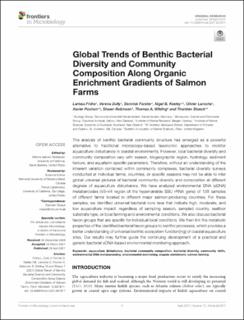| dc.description.abstract | The analysis of benthic bacterial community structure has emerged as a powerful alternative to traditional microscopy-based taxonomic approaches to monitor aquaculture disturbance in coastal environments. However, local bacterial diversity and community composition vary with season, biogeographic region, hydrology, sediment texture, and aquafarm-specific parameters. Therefore, without an understanding of the inherent variation contained within community complexes, bacterial diversity surveys conducted at individual farms, countries, or specific seasons may not be able to infer global universal pictures of bacterial community diversity and composition at different degrees of aquaculture disturbance. We have analyzed environmental DNA (eDNA) metabarcodes (V3–V4 region of the hypervariable SSU rRNA gene) of 138 samples of different farms located in different major salmon-producing countries. For these samples, we identified universal bacterial core taxa that indicate high, moderate, and low aquaculture impact, regardless of sampling season, sampled country, seafloor substrate type, or local farming and environmental conditions. We also discuss bacterial taxon groups that are specific for individual local conditions. We then link the metabolic properties of the identified bacterial taxon groups to benthic processes, which provides a better understanding of universal benthic ecosystem function(ing) of coastal aquaculture sites. Our results may further guide the continuing development of a practical and generic bacterial eDNA-based environmental monitoring approach. | en_US |
